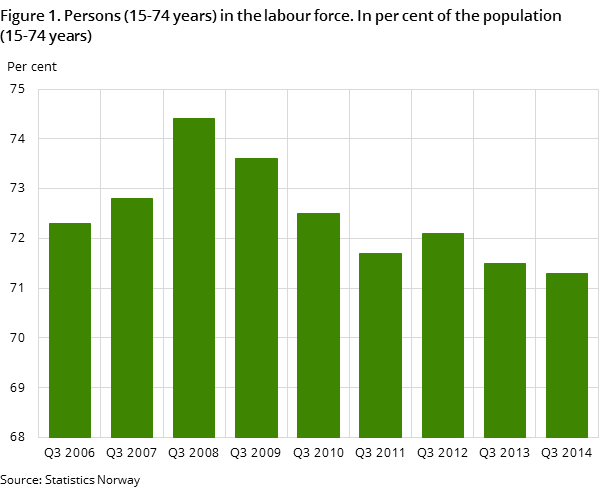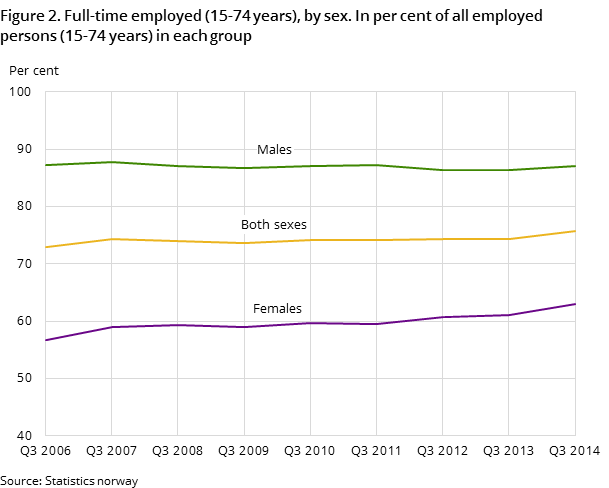Content
Published:
This is an archived release.
Decreased youth labour force participation
The labour force participation rate among those aged 15-24 years decreased from 58.7 per cent in the 3rd quarter of 2013 to 56.1 per cent in the 3rd quarter of 2014. There was an increase in the number of people studying during this period – but a decrease in the number of persons combining studying with part-time work.
| 3rd quarter 2014 | 3rd quarter 2013 - 3rd quarter 2014 | |||
|---|---|---|---|---|
| Absolute numbers | Per cent | Change in absolute numbers | Change in percentage points | |
| Labour force | ||||
| Both sexes | 2 748 000 | 71.3 | 27 000 | -0.2 |
| Males | 1 454 000 | 73.9 | 16 000 | -0.3 |
| Females | 1 294 000 | 68.5 | 11 000 | -0.3 |
| Employed persons | ||||
| Both sexes | 2 646 000 | 68.6 | 20 000 | -0.4 |
| Males | 1 404 000 | 71.4 | 14 000 | -0.3 |
| Females | 1 243 000 | 65.8 | 7 000 | -0.5 |
| Unemployed | ||||
| Both sexes | 102 000 | 3.7 | 7 000 | 0.2 |
| Males | 50 000 | 3.4 | 1 000 | 0.0 |
| Females | 52 000 | 4.0 | 5 000 | 0.4 |


The Labour Force Survey (LFS) shows that the labour force participation rate among the population aged 15-74 years was 71.3 per cent in the 3rd quarter of 2014. This is down by 0.2 percentage points from the same quarter the previous year. The decrease was mainly among the under 25s – especially among men. Among this age group, there has been a decrease in the number of people combining education with part-time work.
Among those aged 30-66 years, there was an increase in labour force participation from the 3rd quarter of 2013 to the same quarter of 2014. Most of this increase was among those aged 55-66 years, especially among women. Labour force participation among women aged 55-66 years was 64.4 per cent in the 3rd quarter of 2014, up from 61.9 per cent in the 3rd quarter of 2013. Labour force participation among men in the same age group increased by 1.4 percentage points during this period, to 72.0 per cent in the 3rd quarter of 2014.
Rise in full-time employment
The LFS shows an increase of 20 000 in the number of employed persons from the 3rd quarter of 2013 to the 3rd quarter of 2014. The last seasonally-adjusted figures indicate that this growth has now stopped. Comparing the 3rd quarter of 2014 with the same quarter of 2013, there has been an increase in the number of full-time employed persons of 52 000. The strongest growth was among women. During the same period, the number of part-time employed persons decreased by 32 000, and most of the decrease was among women. Despite this development, full-time employment is still far more common among men. In the 3rd quarter of 2014, the share of full-time employed persons was 87 per cent among men and 63 per cent among women.
Increased unemployment and long-term unemployment
In the 3rd quarter of 2014, there were 102 000 unemployed persons, up by 7 000 from the same quarter the previous year. The increase was among the long-term unemployed, i.e. persons who have been unemployed for more than 26 weeks. The share of long-term unemployed among the total unemployed was 32 per cent in the 3rd quarter of 2014, up from 28 per cent in the 3rd quarter of 2013. The average period of time an unemployed person is unemployed was 27 weeks in the 3rd quarter of 2014; four weeks longer than in the same quarter the previous year.
Contact
-
Arbeidsmarked og lønn
E-mail: arbeidsmarked@ssb.no
-
Erik Herstad Horgen
E-mail: erik.horgen@ssb.no
tel.: (+47) 93 08 68 62
-
Håvard Hungnes Lien
E-mail: havard.lien@ssb.no
tel.: (+47) 40 90 26 06
